Without a doubt, my favourite Instagram account is Aaron Chang’s. When I say his feed is a true lookbook of Ivy style, I mean it.
Aaron is a fashion illustrator specializing in Ivy-style-inspired works, and each of his pieces has not only captured my imagination and helped me decide what to wear on any given day, but it’s done the same for the thousands who follow him.
"Ivy style has always evolved with the times, reflecting cultural and societal shifts."
Hailing from South Korea, Aaron's interpretation of Ivy style draws inspiration from its golden era while staying firmly grounded in what feels both current and refreshing.
Aaron recently co-launched his new brand, Ivy Boys Archive, and I’m excited to learn more. It felt like the perfect moment to sit down with him.
I’m thrilled to welcome him to Easy On The Ivy to discuss his work, the inspirations behind his craft, and—of course—what he loves to wear.
What initially drew you to Ivy style, and how did it become a central part of your creative work?
About 15 years ago, when I was a university student, I was an avid fan of Scott Schuman’s The Sartorialist. I often carried a camera around, trying to emulate his street photography. Through his work, I was introduced to classic menswear, and I became so passionate about fashion that I would spend countless nights digging through fashion materials and images.
Around this time, I stumbled upon, or perhaps naturally discovered, the photo book Take Ivy. It captivated me completely, and I fell deeply in love with Ivy style. I was so enamoured that I even started wearing ties and jackets to my classes—something that was quite unusual for the average Korean student.
About a decade later, trends had changed, and both The Sartorialist and Take Ivy faded from my memory. By then, I had transitioned into corporate life.
I started drawing as a way to bring some excitement and change to my monotonous office routine. Initially, my drawings didn’t have a specific theme; it was simply a casual hobby. One day, I happened to pull Take Ivy off my bookshelf again. Even after 10 years, the photos felt as fresh and inspiring as ever, and they brought back memories of my college days and my passion for Ivy fashion. That’s when I decided to illustrate it, and it marked the beginning of my journey as a dedicated fashion illustrator.
Congratulations on the launch of Ivy Boys Archive! It’s such an exciting project. What inspired you to start this brand, and how does it reflect your larger vision for Ivy style?
Ever since I was young, I’ve loved clothing and dreamed of launching my own brand someday. While working as a visual director at New Balance Korea for many years, I was able to prepare myself for the business side of fashion. When I met the right partner (Nelson Yap from Benjamin Barker Group), the idea for IVB Archive was born.
Ivy Boys Archive is a fashion brand that reinterprets American vintage casual style with a modern twist. I’ve infused the brand with my own preferences, knowledge, fit expertise, and design sensibilities. The goal was to create clothing I would want to wear myself—pieces that would also resonate with other Ivy boys around the world. We’re officially launching next year, so stay tuned.
As one of your fans, I can say that your work has had a big influence on my own style. Do you draw inspiration from places outside of clothing, like music, film, or art?
Absolutely. I always listen to music when I draw, as it inspires me greatly. I particularly enjoy tracks by jazz musicians like Miles Davis and John Coltrane, as well as Japanese city pop. I aim to imbue my illustrations with the freedom of jazz and the refreshing energy of city pop.
Additionally, whenever I collaborate with brands from different countries, I make it a habit to explore that country’s popular music. It helps set the tone for my creative process and has a significant impact on my mood and approach to the work.
Your style is rooted in traditional Ivy aesthetics but feels modern and fresh. How do you define Ivy style in today’s menswear landscape?
In Korea, Ivy fashion often evokes a specific, somewhat rigid image—think traditional Brooks Brothers or Polo looks, or even the Americana workwear style: a navy blazer with a tie, chinos or fatigues, and loafers. While that classic look is undoubtedly stylish and preserving tradition is important, I prefer adding a personal twist. I find it more fun and stylish to reinterpret Ivy style in unique ways.
In today’s world, wearing an OCBD shirt and a blazer might feel formal, but historically, those items were sportswear. Back when Ivy style emerged, it was seen as progressive and modern, especially compared to the tuxedos worn by traditional gentlemen of the time. This means Ivy style has always evolved with the times, reflecting cultural and societal shifts. I believe Ivy boys have consistently carried on the tradition while simultaneously embracing modern sensibilities—because that’s what makes it fun and stylish.
You’ve collaborated with amazing brands like New Balance. Are there any projects or collaborations that stand out as particularly memorable? If so, what made them special?
Two come to mind. The first is the Ivy Boys NFT project. I always try to reimagine traditional concepts in new ways, which is why I focus on digital illustrations rather than traditional methods. The NFT project was an extension of that effort. We created 7,777 Ivy Boy NFTs, all of which sold out. I see myself as a bridge between the traditional world of Ivy style and cutting-edge technology like NFTs. It was meaningful to show people that Ivy style can evolve in unexpected ways and expand its horizons.
The second memorable collaboration was with J.Press. Partnering with one of the original Ivy style brands with such a rich history felt like a recognition of my work. I believe the collaboration was significant in creating a fresh image for J.Press, one that didn’t previously exist.
Are there any go-to items or favourite pieces in your wardrobe?
My preferences change over time, but when I was working in a corporate office, my favourite item was a white oxford button-down shirt. I had about seven of them from different brands and would rotate them throughout the week. They pair well with almost anything.
Recently, I’ve been enjoying the Resolute 711 model selvedge denim. It’s fun to watch the wash develop over time.
I also wear hats almost daily, and the yellow cap I designed for the J.Press collaboration has become my favourite piece lately.
For someone new to Ivy style, what would be the first item you recommend, and how should they style it?
Chinos. If you style them with natural colours, you can’t go wrong. Think of the earth and sky: pair brown chinos with a light blue OCBD shirt, and you’ve got a perfect combination. Recently, I purchased a pair of chinos from CIOTA, and the quality is excellent.
One of Ivy style’s greatest strengths is its timelessness. Why do you think Ivy style has remained so beloved over the years?
As I mentioned earlier, Ivy style has managed to preserve tradition while continuously embracing modernity and evolving in a way that feels natural. It’s like a tree with deep roots and ever-expanding branches.
Additionally, while Ivy style gives off a polished and respectful appearance, it originated as a university student’s style. There’s an inherent sense of rebellion and youthfulness that you can’t ignore. It’s this blend of contrasting elements that I believe makes it so enduring.
Are there any particular details or elements of Ivy style that you wish people paid more attention to, such as specific fabrics, silhouettes, or accessories?
Its versatility. With just a few jackets, shirts, and pants, you can create an astonishing variety of stylish looks. The items in Ivy style mix and match so well together that it’s hard to go wrong. These pieces are suitable for formal occasions, workdays, or even casual weekend outings.
Finally, what do you hope to see in the future of Ivy style? How do you see your work contributing to its evolution?
I hope Ivy style continues to embrace diversity and modernity while maintaining its tradition and elegance.
Fashion has always reflected the times. What we now call Ivy fashion represented the dominant culture of the ’60s and ’70s. If the Ivy boys of that era listened to jazz and played rugby or sailed, perhaps today’s Ivy boys listen to hip-hop and ride skateboards.
Brands like J.Press and Noah exemplify this evolution by blending streetwear, hip-hop, and skate culture with Ivy style. This is possible because Ivy style is more than just a fashion—it’s a culture. Its strong foundation allows it to adapt and evolve with the times.
I hope to be part of this change as one of the pioneers expanding its scope. As an illustrator, I aim to contribute through my art, and as the director of IVB Archive, I will broaden Ivy style’s boundaries through fashion. My vision is to introduce Ivy style to more people and show them how it can be reimagined in fresh and exciting ways.
A huge thanks to Aaron for taking the time to chat and share his story. It’s always inspiring to hear from someone who’s not only pushing the boundaries of Ivy style but making it their own in such a creative way. Be sure to check out more of his work on Instagram at @aron_ch – it's an incredible source of menswear inspiration.


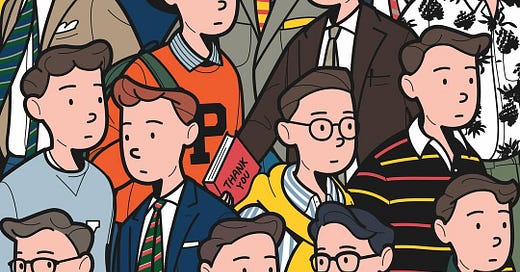







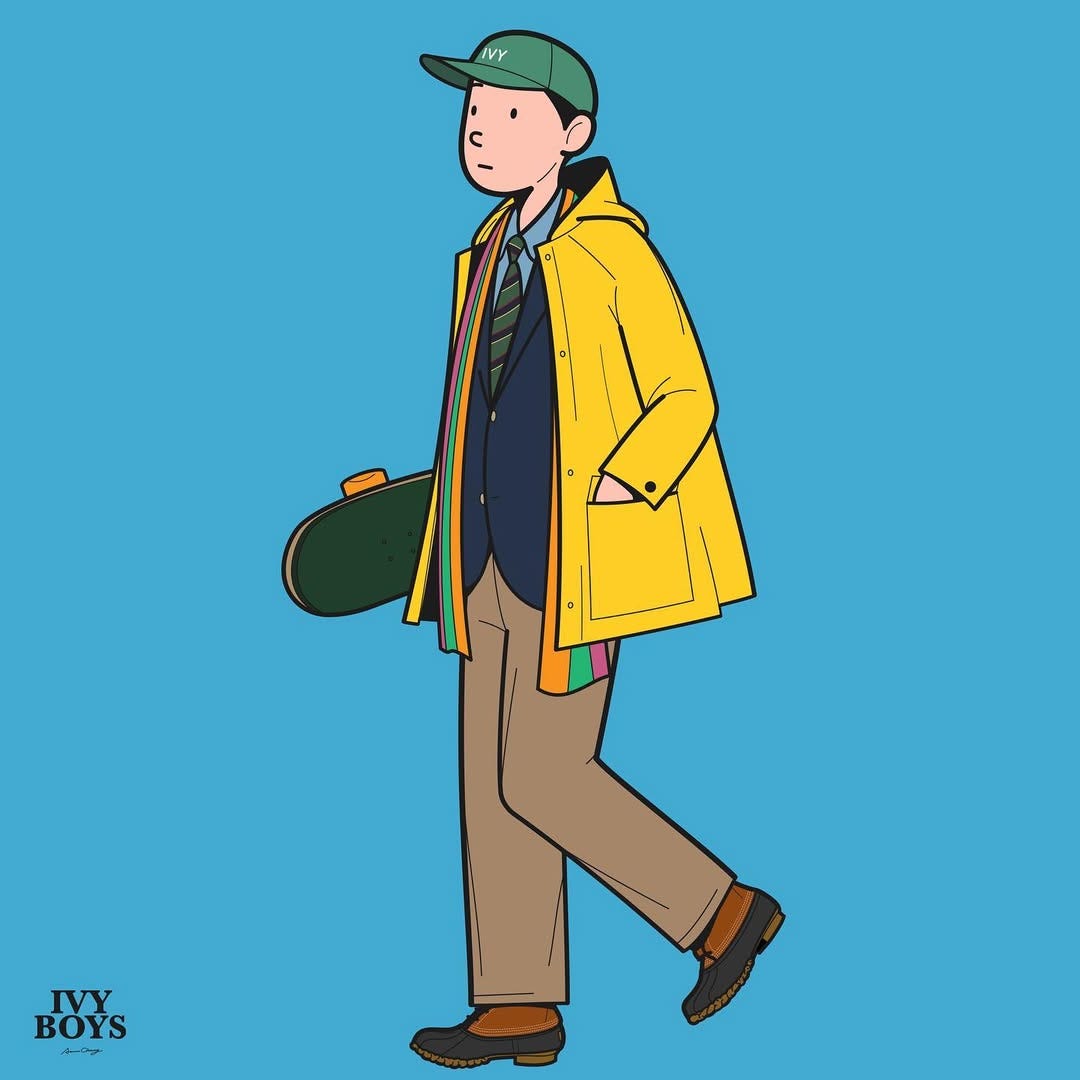



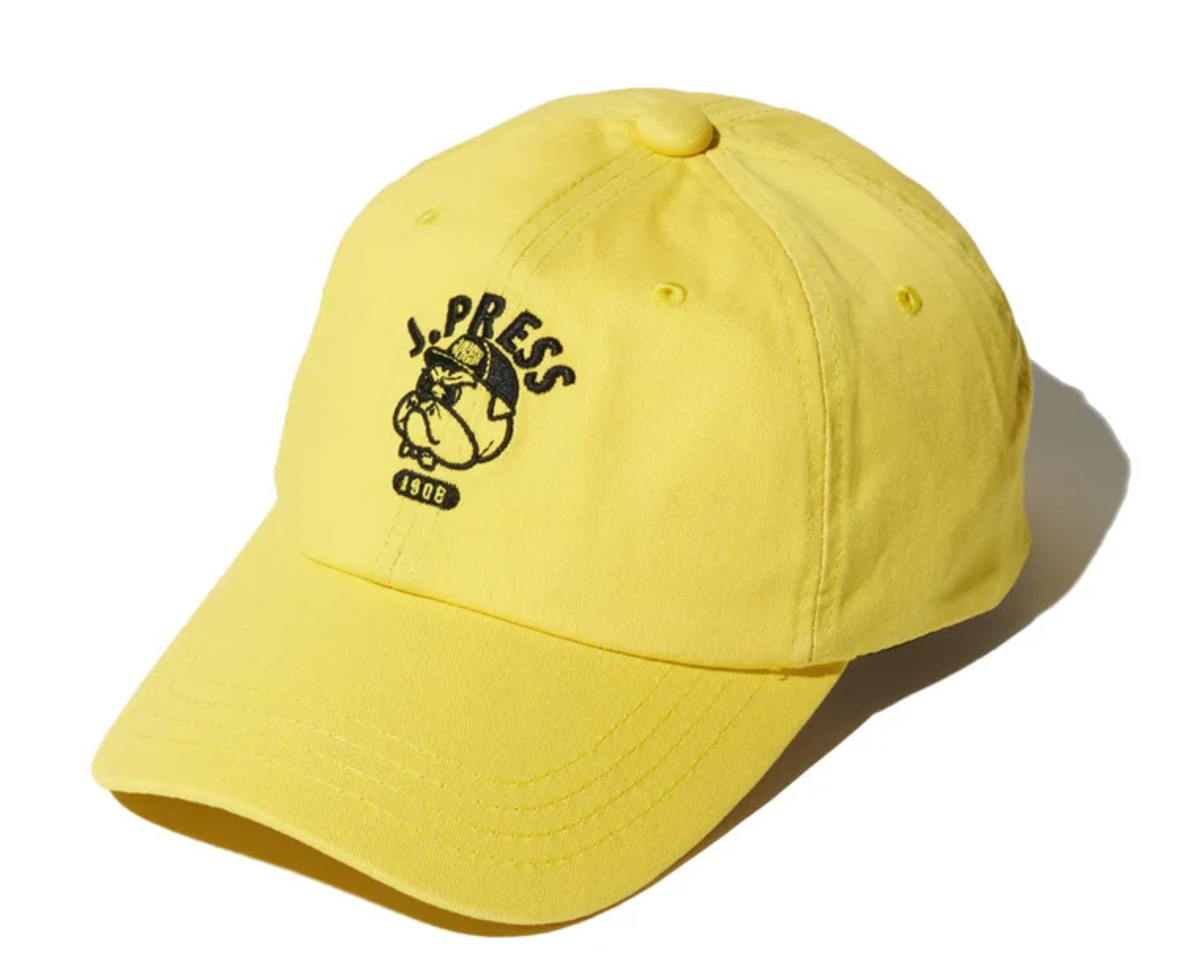

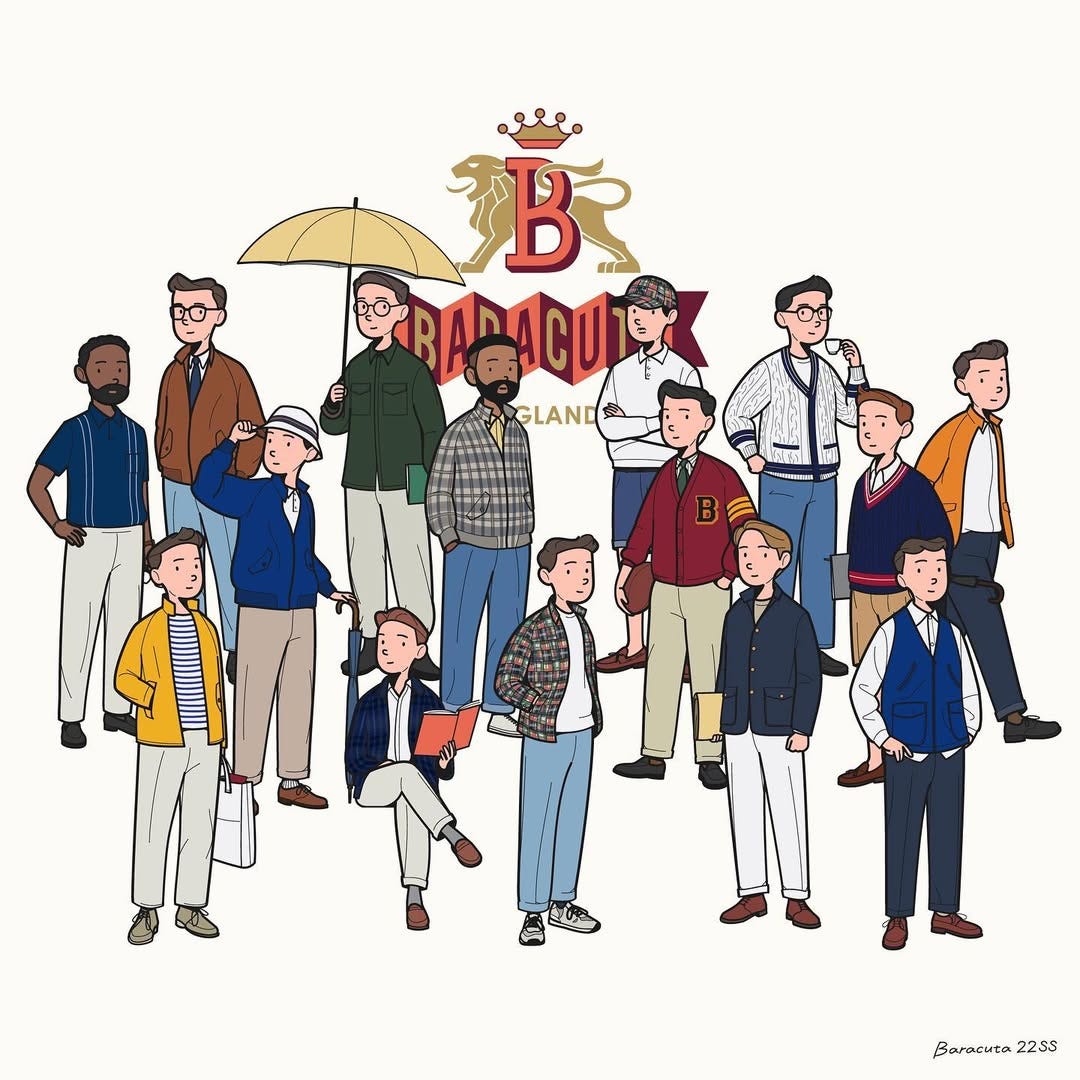
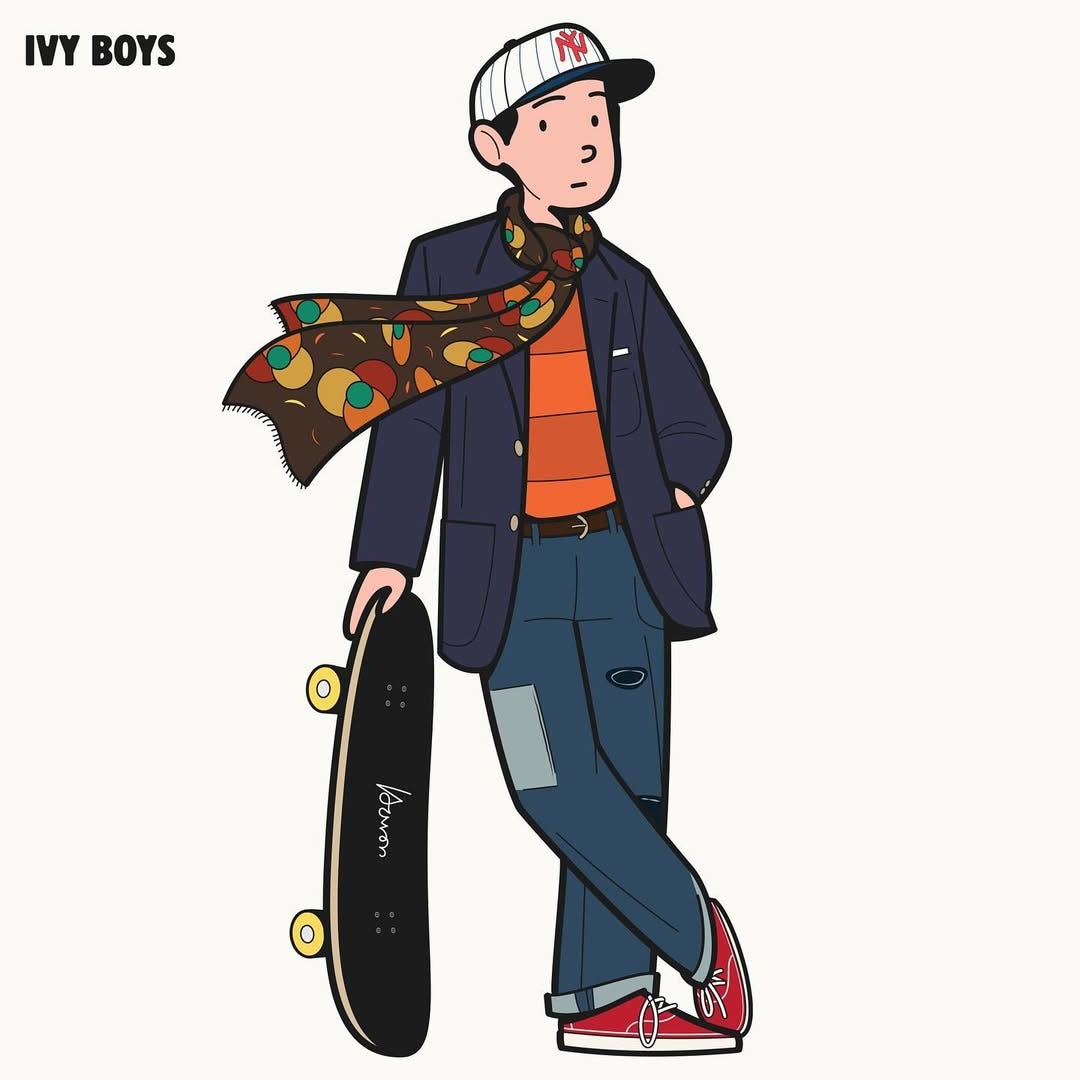
Great interview! I like how Aaron interweaves fashion, art, music and style into his work.